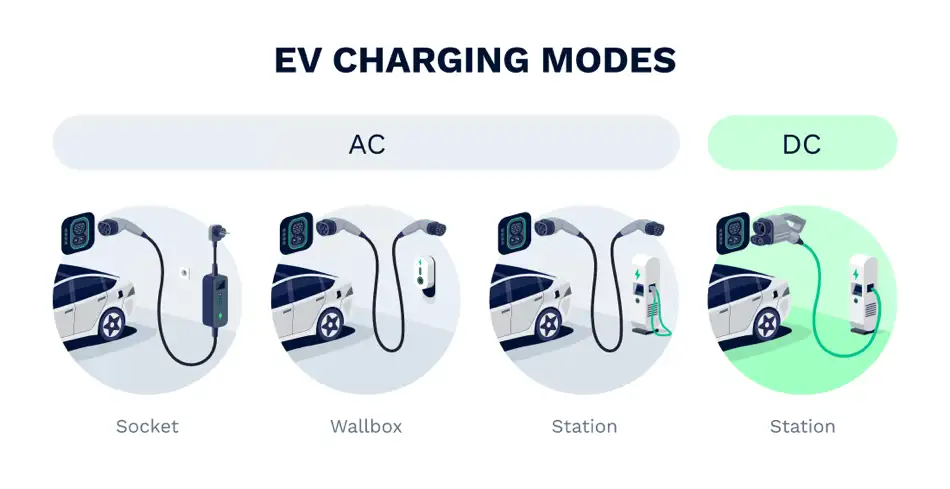Electric vehicle (EV) charging modes are various types of chargers that can be used to charge an electric vehicle. The voltage and amperage of the charger determine the charging mode. Four different charging modes are available, each with varying availability, charging speed, advantages, and drawbacks. For further information, continue reading.
Mode 1: Standard household outlet
One charging option for electric vehicles is using a standard household outlet, also known as level 1 EV charging. This method is widely available and inexpensive, as any electric socket can be used. However, it has a slow charging speed of only 1-2 miles per hour on average. The voltage for this option is 120V, and the amperage is 12-16A. It’s important to note that this method has no safety features. You can find a standard household outlet in your home, workplace, or public places. It’s typically recommended as a last resort if no faster charging options are available.
Mode 2: Portable EVSE with a standard household outlet
Mode 2 is a portable Electric Vehicle Supply Equipment (EVSE) that can be connected to a standard household outlet. It offers convenience and is relatively affordable compared to other modes. However, its charging speed is still slow, with an average of 2-5 miles per hour. The voltage is 120V, and the amperage ranges from 12-16A, with overcurrent protection as the typical safety feature. This mode can be found at home, workplace, or public places. Some EV models come with a portable EVSE, while others require you to purchase one. It is a good option to consider if you live in an apartment with a nearby socket.
Mode 3: Dedicated EVSE connected to 240V outlet
One charging method for electric vehicles is Mode 3, which uses a dedicated EVSE connected to a 240V outlet. The advantages of this method include faster charging speeds, typically around 10-35 miles per hour. However, it is also more expensive than Mode 1 or 2. The voltage for Mode 3 is 240V, with an amperage of 32-40A. Safety features typically include overcurrent protection, ground fault protection, and temperature protection. This method can be found in homes, workplaces, and public places. It requires an electrician to install your home EV charger. Additionally, it’s worth noting that your utility company may offer rebates for installing this type of charging system depending on where you live.
Mode 4: DC fast charger
One of the quickest ways to charge your electric vehicle (EV) is through a DC fast charger, which is available in Mode 4. This option can charge your EV at up to 650 miles per hour. Depending on your EV model and the DC fast charger you are using, it can take anywhere between 18 minutes to over an hour to charge from 10% to 80% capacity. However, it is worth noting that this is the most expensive charging option and may not be as widely available as Mode 3.
DC fast chargers operate on a voltage of DC and an amperage of 50-350 kW. They can be found along highways, at rest stops, and in public places. It is important to bear in mind that there are three DC fast charger standards (CCS, CHAdeMO, and Tesla), and depending on your EV model, you may only be able to use compatible charging standards. While the infrastructure for DC EV charging is still growing, it is limited and varies depending on where you live.
Additional considerations
When considering charging options for your electric vehicle, it’s important to consider a few factors. First, be aware that some EVs require a compatible type of DC Fast charger. Additionally, if you plan to charge your car at home, you’ll need to make sure you have a 240V outlet available to get the most out of your EV. Remember that the cost of EV chargers can vary widely, ranging from a few hundred dollars to several thousand dollars. Finally, not all charging stations are created equal – some are faster and more reliable than others.
In conclusion, your specific requirements and financial constraints will determine the optimal EV charging mode for you. If your daily commute is short and you can charge your vehicle overnight, Modes 1 or 2 may be adequate. However, if you have a lengthy commute or require a fast charging option, Modes 3 or 4 may be preferable. Use our needs-based search to find the electric vehicle that best suits you.
